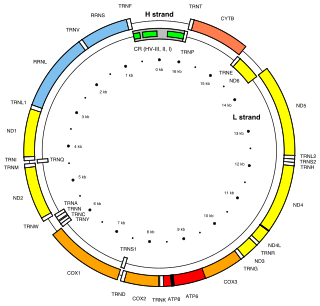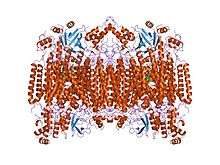Cytochrome c oxidase subunit III
"COX3" redirects here. For the cyclooxygenase isoenzyme, see
COX-3.

Location of the MT-CO3 gene in the human mitochondrial genome. MT-CO3 is one of the three cytochrome c oxidase subunit mitochondrial genes (orange boxes).
Cytochrome c oxidase subunit 3 is an enzyme that in humans is encoded by the MT-CO3 gene.[3]
Cytochrome c oxidase subunit III is one of main transmembrane subunits of cytochrome c oxidase.
Function
Cytochrome c oxidase (EC 1.9.3.1) is the terminal enzyme of the respiratory chain of mitochondria and many aerobic bacteria. It catalyzes the transfer of electrons from reduced cytochrome c to molecular oxygen:
- 4 cytochrome c+2 + 4 H+ + O2
 4 cytochrome c+3 + 2 H2O
4 cytochrome c+3 + 2 H2O
This reaction is coupled to the pumping of four additional protons across the mitochondrial or bacterial membrane.[4][5]
Cytochrome c oxidase is an oligomeric enzymatic complex that is located in the mitochondrial inner membrane of eukaryotes and in the plasma membrane of aerobic prokaryotes. The core structure of prokaryotic and eukaryotic cytochrome c oxidase contains three common subunits, I, II and III. In prokaryotes, subunits I and III can be fused and a fourth subunit is sometimes found, whereas in eukaryotes there are a variable number of additional small subunits.[6]
As the bacterial respiratory systems are branched, they have a number of distinct terminal oxidases, rather than the single cytochrome c oxidase present in the eukaryotic mitochondrial systems. Although the cytochrome o oxidases do not catalyze the cytochrome c but the quinol (ubiquinol) oxidation they belong to the same haem-copper oxidase superfamily as cytochrome c oxidases. Members of this family share sequence similarities in all three core subunits: subunit I is the most conserved subunit, whereas subunit II is the least conserved.[7][8][9]
Clinical significance
Mutations in mtDNA-encoded cytochrome c oxidase subunit genes have been observed to be associated with isolated myopathy or severe encephalomyopathy.[10]
Subfamilies
References
- ↑ "Human PubMed Reference:".
- ↑ Miki K, Sogabe S, Uno A, et al. (May 1994). "Application of an automatic molecular-replacement procedure to crystal structure analysis of cytochrome c2 from Rhodopseudomonas viridis". Acta Crystallogr. D. 50 (Pt 3): 271–5. doi:10.1107/S0907444993013952. PMID 15299438.
- ↑ "Entrez Gene: COX3 cytochrome c oxidase subunit III".
- ↑ Michel H (1999). "Cytochrome c oxidase: catalytic cycle and mechanisms of proton pumping--a discussion". Biochemistry. 38 (46): 15129–15140. doi:10.1021/bi9910934. PMID 10563795.
- ↑ Wikstrom M, Belevich I, Verkhovsky MI (2006). "Proton-coupled electron transfer drives the proton pump of cytochrome c oxidase". Nature. 440 (7085): 829–32. doi:10.1038/nature04619. PMID 16598262.
- ↑ Mather MW, Springer P, Hensel S, Buse G, Fee JA (1993). "Cytochrome oxidase genes from Thermus thermophilus. Nucleotide sequence of the fused gene and analysis of the deduced primary structures for subunits I and III of cytochrome caa3". J. Biol. Chem. 268 (8): 5395–5408. PMID 8383670.
- ↑ Danchin A, Glaser P, Kunst F, Rapoport G, Santana M, Hullo MF (1992). "Molecular cloning, sequencing, and physiological characterization of the qox operon from Bacillus subtilis encoding the aa3-600 quinol oxidase". J. Biol. Chem. 267 (15): 10225–10231. PMID 1316894.
- ↑ Lemieux L, Gennis RB, Chepuri V, Au DC (1990). "The sequence of the cyo operon indicates substantial structural similarities between the cytochrome o ubiquinol oxidase of Escherichia coli and the aa3-type family of cytochrome c oxidases". J. Biol. Chem. 265 (19): 11185–11192. PMID 2162835.
- ↑ Rumbley J, Gennis RB, Garcia-Horsman JA, Barquera B, Ma J (1994). "The superfamily of heme-copper respiratory oxidases". J. Bacteriol. 176 (18): 5587–5600. PMC 196760
 . PMID 8083153.
. PMID 8083153. - ↑ Horváth, R; Schoser, BG; Müller-Höcker, J; Völpel, M; Jaksch, M; Lochmüller, H (2005). "Mutations in mtDNA-encoded cytochrome c oxidase subunit genes causing isolated myopathy or severe encephalomyopathy". Neuromuscular disorders : NMD. 15 (12): 851–7. doi:10.1016/j.nmd.2005.09.005. PMID 16288875.
Further reading
- Moraes CT, Andreetta F, Bonilla E, et al. (1991). "Replication-competent human mitochondrial DNA lacking the heavy-strand promoter region". Mol. Cell. Biol. 11 (3): 1631–7. PMC 369459
 . PMID 1996112.
. PMID 1996112.
- Chomyn A, Cleeter MW, Ragan CI, et al. (1986). "URF6, last unidentified reading frame of human mtDNA, codes for an NADH dehydrogenase subunit". Science. 234 (4776): 614–8. doi:10.1126/science.3764430. PMID 3764430.
- Chomyn A, Mariottini P, Cleeter MW, et al. (1985). "Six unidentified reading frames of human mitochondrial DNA encode components of the respiratory-chain NADH dehydrogenase". Nature. 314 (6012): 592–7. doi:10.1038/314592a0. PMID 3921850.
- Anderson S, Bankier AT, Barrell BG, et al. (1981). "Sequence and organization of the human mitochondrial genome". Nature. 290 (5806): 457–65. doi:10.1038/290457a0. PMID 7219534.
- Montoya J, Ojala D, Attardi G (1981). "Distinctive features of the 5'-terminal sequences of the human mitochondrial mRNAs". Nature. 290 (5806): 465–70. doi:10.1038/290465a0. PMID 7219535.
- Andrews RM, Kubacka I, Chinnery PF, et al. (1999). "Reanalysis and revision of the Cambridge reference sequence for human mitochondrial DNA". Nat. Genet. 23 (2): 147. doi:10.1038/13779. PMID 10508508.
- Ingman M, Kaessmann H, Pääbo S, Gyllensten U (2001). "Mitochondrial genome variation and the origin of modern humans". Nature. 408 (6813): 708–13. doi:10.1038/35047064. PMID 11130070.
- Maca-Meyer N, González AM, Larruga JM, et al. (2003). "Major genomic mitochondrial lineages delineate early human expansions". BMC Genet. 2: 13. doi:10.1186/1471-2156-2-13. PMC 55343
 . PMID 11553319.
. PMID 11553319.
- Herrnstadt C, Elson JL, Fahy E, et al. (2002). "Reduced-Median-Network Analysis of Complete Mitochondrial DNA Coding-Region Sequences for the Major African, Asian, and European Haplogroups". Am. J. Hum. Genet. 70 (5): 1152–71. doi:10.1086/339933. PMC 447592
 . PMID 11938495.
. PMID 11938495.
- Silva WA, Bonatto SL, Holanda AJ, et al. (2002). "Mitochondrial Genome Diversity of Native Americans Supports a Single Early Entry of Founder Populations into America". Am. J. Hum. Genet. 71 (1): 187–92. doi:10.1086/341358. PMC 384978
 . PMID 12022039.
. PMID 12022039.
- Elkon H, Don J, Melamed E, et al. (2003). "Mutant and wild-type alpha-synuclein interact with mitochondrial cytochrome C oxidase". J. Mol. Neurosci. 18 (3): 229–38. doi:10.1385/JMN:18:3:229. PMID 12059041.
- Mishmar D, Ruiz-Pesini E, Golik P, et al. (2003). "Natural selection shaped regional mtDNA variation in humans". Proc. Natl. Acad. Sci. U.S.A. 100 (1): 171–6. doi:10.1073/pnas.0136972100. PMC 140917
 . PMID 12509511.
. PMID 12509511.
- Ingman M, Gyllensten U (2003). "Mitochondrial Genome Variation and Evolutionary History of Australian and New Guinean Aborigines". Genome Res. 13 (7): 1600–6. doi:10.1101/gr.686603. PMC 403733
 . PMID 12840039.
. PMID 12840039.
- Kong QP, Yao YG, Sun C, et al. (2003). "Phylogeny of East Asian Mitochondrial DNA Lineages Inferred from Complete Sequences". Am. J. Hum. Genet. 73 (3): 671–6. doi:10.1086/377718. PMC 1180693
 . PMID 12870132.
. PMID 12870132.
- Temperley RJ, Seneca SH, Tonska K, et al. (2004). "Investigation of a pathogenic mtDNA microdeletion reveals a translation-dependent deadenylation decay pathway in human mitochondria". Hum. Mol. Genet. 12 (18): 2341–8. doi:10.1093/hmg/ddg238. PMID 12915481.
- Maca-Meyer N, González AM, Pestano J, et al. (2004). "Mitochondrial DNA transit between West Asia and North Africa inferred from U6 phylogeography". BMC Genet. 4: 15. doi:10.1186/1471-2156-4-15. PMC 270091
 . PMID 14563219.
. PMID 14563219.
- Coble MD, Just RS, O'Callaghan JE, et al. (2004). "Single nucleotide polymorphisms over the entire mtDNA genome that increase the power of forensic testing in Caucasians". Int. J. Legal Med. 118 (3): 137–46. doi:10.1007/s00414-004-0427-6. PMID 14760490.
- Palanichamy MG, Sun C, Agrawal S, et al. (2005). "Phylogeny of Mitochondrial DNA Macrohaplogroup N in India, Based on Complete Sequencing: Implications for the Peopling of South Asia". Am. J. Hum. Genet. 75 (6): 966–78. doi:10.1086/425871. PMC 1182158
 . PMID 15467980.
. PMID 15467980.
- Starikovskaya EB, Sukernik RI, Derbeneva OA, et al. (2005). "Mitochondrial DNA diversity in indigenous populations of the southern extent of Siberia, and the origins of Native American haplogroups". Ann. Hum. Genet. 69 (Pt 1): 67–89. doi:10.1046/j.1529-8817.2003.00127.x. PMC 3905771
 . PMID 15638829.
. PMID 15638829.
- Rajkumar R, Banerjee J, Gunturi HB, et al. (2006). "Phylogeny and antiquity of M macrohaplogroup inferred from complete mt DNA sequence of Indian specific lineages". BMC Evol. Biol. 5: 26. doi:10.1186/1471-2148-5-26. PMC 1079809
 . PMID 15804362.
. PMID 15804362.
External links


 . PMID 8083153.
. PMID 8083153. . PMID 1996112.
. PMID 1996112. . PMID 11553319.
. PMID 11553319. . PMID 11938495.
. PMID 11938495. . PMID 12022039.
. PMID 12022039. . PMID 12509511.
. PMID 12509511. . PMID 12840039.
. PMID 12840039. . PMID 12870132.
. PMID 12870132. . PMID 14563219.
. PMID 14563219. . PMID 15467980.
. PMID 15467980. . PMID 15638829.
. PMID 15638829. . PMID 15804362.
. PMID 15804362.